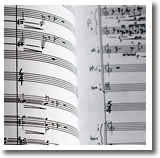Hamelin: chamber opera in two acts - Part 2
Recorded at the Factory Space, Sligo/IR, 2003.
Ian Wilson, music; Lavinia Greenlaw, libretto; Gavin Quinn, director.
... there occurred an unheard-of and to-all-times-remarkable and sad event concerning the children at Hameln on the Wäser in the Brunswick county; an event which may readily be a warning to parents to look diligently after their children.
Stories often arise from the need to explain something: why the sun disappears at night, why it’s not a good idea to go into the woods after dark and why 130 children disappeared from a small town in northern Germany in the late thirteenth century.
The legend of the Pied Piper is so familiar that we take it, literally, as read. It is a fairytale with a stern moral and no happy ever after. Its meaning seems obvious, but how did it arise? I wanted this opera to probe that question - how such stories come about and what we use them for.
It has been said that the story derives from Indo-Germanic myth - the Piper as a god of death piping away people’s souls which squeak and gibber like rats; or from reports of ‘dancing mania’, often related to the consumption of bread made with rye infected by a fungus called ergot, which has the same hallucinogenic effects as LSD; or from the dances traditionally held on St John’s Day, when the events in Hamelin are supposed to have occurred. The disappearance of the children is even thought to be related to the Children’s Crusade of 1211.
Whatever the legend’s starting point, it has a palpable sense of being prompted by some actual event. Among all the varying details, one remains consistent: where the number of children is mentioned, it is always 130. In Hamelin itself, the disappearance was apparently treated as historical fact:
... such a history is painted on a window in the parish church ... The pitiful wonder is also inscribed in the town book, and the folk of Hameln are accustomed in their writing to date their letters from the loss of the children. Some set down this wonder in the year 1282.
When Ian Wilson asked me to write his libretto, he said that he had in mind an opera about the ‘Crippled Child’ left behind by the Piper. I was working on a novel about a girl growing up in, and out of, a village and was fascinated by how people get cast in local stories. What role does this girl play in the story of her town?
She has been an outcast but is now a witness, although unsure of what she’s seen. The Doctor and the Mayor, who have taken control of the town in this time of crisis, are keen to persuade her of their version of events. These are desperate times and there are many secrets to hide. They also have a more clinical reason for holding on to her. Here, I was exploring the murkier side of any small world: the belief in the superiority of ‘people like us’ and the fear of all things foreign. Although deformed, the Girl is of pure Hamelin stock and with so many disappeared, the two men think of her as a woman who might one day produce more Hamelin men.
It’s important to see that the Girl is not entirely innocent. She is flattered to find herself the centre of attention and gets carried away by romantic daydreams, believing the men’s promise to fix her leg and find her a young man. I placed her in a triangle with the Doctor and the Mayor to emphasise her vulnerability but also to keep things unbalanced. She has power now, as a central character in a story which is going to save the town.
they could not but haue kept memorie of so strange a thing, if indeed any such thing had there hapned
The trouble is that she’s not sure what really happened. She is haunted by things she thinks she saw or heard and which suggest that the disappearance of the children has a far more ominous explanation.
When she realizes that she has been used, and that the Doctor and Mayor are about to discard her, she needs a way out of the situation. The town is becoming famous and so can she, but only if she colludes with the men in perpetuating something she knows deep down is only a myth. This is as much a matter of survival as it is of ambition. She is a young woman without money or family, and her bad leg means she would not be accepted elsewhere unless she has something to offer. Her passport, or currency, is the story.
Why should not the historians and folk-lorists leave us our Piper. his pipe, his pied clothing and his rats, instead of trying to explain him away?
The Crippled Girl left outside the mountain forces the door to the meaning of the Pied Piper to remain open.
(Excerpts from Exodus Hamlensis, S. Erich, Hanover 1655)
Lavinia Greenlaw, London, July 2003.


